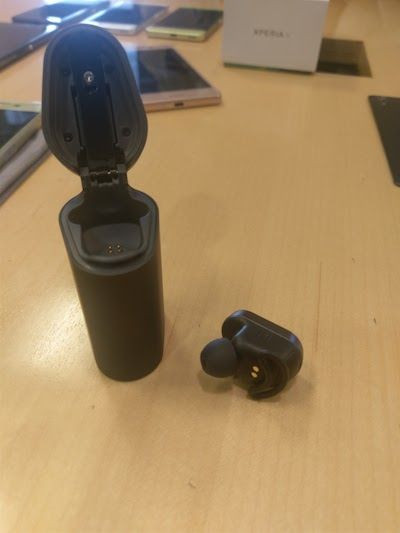One of Sony’s upcoming devices is quite inconspicuous, but the manufacturer hopes it will become an essential wearable for tech enthusiasts on the go. The sleek, black case flips up like a lighter, but inside houses the Sony Xperia Ear. The earpiece is Sony’s answer to many of the virtual assistant options now being introduced and expanded upon by tech companies.
Sony Senior Director of Marketing Don Mesa compared the Xperia Ear to the artificial intelligence operating system from the 2013 film Her. Users should expect the Xperia Ear to give them contextual information, like notifying them of a traffic jam and suggesting they leave the house earlier for that 9 a.m. meeting.
“It’s the whole evolution of communication, so you’re not always looking at your screen. If you think about it, it looks like a Bluetooth headset, but we’ve put all these sensors in it,” Mesa told iDigitalTimes. “You can wake up in the morning, put this in your ear and you’re fed information, like your morning routine; you’re getting the weather, your schedule.”

The Xperia Ear is expected to launch later this summer, and will likely go through a host of evolution itself before it meets the level of functionality of Sony’s original concept. The manufacturer hopes the Xperia Ear will eventually be standalone, but it will launch as a connected device. It will work with a mobile application and will likely go through a procession from Xperia compatibility to Android compatibility to standalone.
“We’re going to go through all the iterations but we wanted to make sure we have at least the intelligence part down. Meaning it’s an app that resides on a device we want to make sure it’s operable on many devices,” Mesa said. “Right now our concepts are meant to be standalone.”
The Xperia Ear will be an interesting, wearable take to what many other manufacturers are doing with voice command and artificial intelligence protocol. Google unveiled its Google Assistant artificial intelligence at its I/O conference in May, which will work with phones, tablets, cars, computers and Google Home. Sony is investigating similar software for the Xperia Ear, according to Mesa, but it may be a part of the manufacturer’s longer-term plans.
“We haven’t made any confirmed information about whether we’re using [Google’s] voice technology. We are looking at our own proprietary as well as third party voice commands,” Mesa told iDigi.

Sony isn’t the only manufacturer toying with the parameters of wearables. Samsung recently showcased an upcoming product of its own, the Icon X earbuds , which can work as standalone wireless headphones. However, they have no AI software and have already revealed possible limitations, including short battery life. Like the Xperia Ear, the Icon X earbuds come in an electronic case, which doubles as a charging port. The Icon X earbuds are also expected to release later in the summer.
While manufacturers strive toward major advancements in the products we buy, consumers will have to be patient while the technology catches up to the concepts of which many have been dreaming.
“We wanted to start humble and get this down right. It’s more important to get the information through,” Mesa told iDigi. “Communication can be person to person but also device to person. We feel this is where we can expand and innovate.”
















